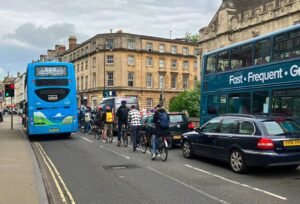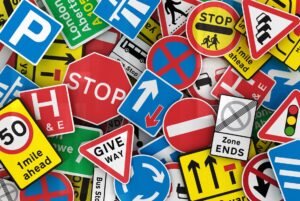The right to drive?
By Ian Loader
Ian is Professor of Criminology at the University of Oxford, and a member of Cyclox
For over 60 years, cities have been dominated by the car. Oxfordshire County Council’s proposals to reduce traffic in our city – using LTNs, congestion-charging and traffic filters – have been portrayed as an attack on cherished liberties. Critics claim they will ‘trap’ residents in their neighbourhoods and curtail people’s right to drive where they see fit.
Do cars mean freedom?

Many drivers equate cars with freedom. For some people the car is essential to their lives and livelihoods. These are people who would benefit from less traffic on our roads. The car means freedom to travel when and where one wishes, without relying on timetables. The car is dry, warm and guarantees a seat. It offers valuable ‘me time’, or conversation with family and friends. These are the comforts that people imagine to be threatened.
What do we overlook when we see the car as representing freedom? Drivers have to forget the impact of car-dominance on the safety and quality of the environment. These costs fall on pedestrians and cyclists who have restricted space and the daily risk of injury. They fall on residents in neighbourhoods whose streets have (without their consent) become rat runs. The burdens are felt by children whose play space has disappeared. The health costs are suffered by all of us (drivers included) having to breathe traffic-polluted air.
The reality of car travel
But what about the actual experience of driving? As people in Oxford know, this means sitting in traffic jams.
The ‘freedom’ represented by the car is compromised the moment other drivers seek to enjoy it.
The costs of car travel are often priced into people’s routines and treated as a fact of modern life rather than a problem to be tackled. If drivers propose solutions to these costs, these often involve creating more road space (despite evidence that more roads attract more traffic), or opposing traffic-reduction schemes. Such opposition forgets that Oxford’s road infrastructure is the product of policy decisions taken during the heyday of car dominance.

Driving also means submitting to a hyper-regulated environment. Cars must meet safety and emissions standards. At three years old, vehicles require an annual inspection by state-authorised garages. If a car fails the MOT test, its owner is banned from using their own property. Drivers are required to be trained, licensed and insured. This suggests that the ‘freedom’ to drive is not a right, but permission to operate dangerous machinery. Licence to operate that machinery depends upon drivers demonstrating they can do so safely.
When they take to the road, drivers enter a transport network dominated by instructions and prohibitions. They and their passengers must wear a seat belt. Drivers cannot consume alcohol or use a mobile phone. Motorists are told where, in what direction, and at what speed they can drive. Rules govern when they can stop and go. When it comes to parking, a range of micro-controls tell drivers where, when and for how long they can occupy public space with their property. For the motoring lobby, the car is a vehicle of personal freedom. But the reality of car use is subjection to state control – a far greater range of surveillance than most drivers would be willing to accept in any other part of their lives.
Rebalancing our city
A debate is underway about how to rebalance our city to meet the needs of all road users, not just drivers. We will be better placed to have that debate if we abandon the illusion that driving is a threatened realm of personal freedom, recognise that car-use is a heavily regulated, routinely frustrating and socially damaging form of convenience, and rediscover the benefits and enjoyment of alternatives to the car.

One Response
I get the point about people that can drive but choice not to. However I this it lacks understand, and perhaps even compassion, for people that are not able to cycle or walk for long periods. I think a better approach would be to be more inclusive of the whole population and not make disabled people feel bad for having to drive. I wonder if, as a cycling community (hence presumably quite physically active), you would be more interested in building bridges with people with disabilities rather that putting all drivers in one pot and having a go?